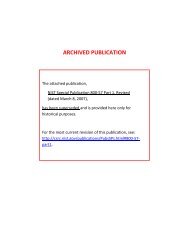NISTIR 7298 Revision 1, Glossary of Key Information Security Terms
NISTIR 7298 Revision 1, Glossary of Key Information Security Terms
NISTIR 7298 Revision 1, Glossary of Key Information Security Terms
You also want an ePaper? Increase the reach of your titles
YUMPU automatically turns print PDFs into web optimized ePapers that Google loves.
NIST IR <strong>7298</strong> <strong>Revision</strong> 1, <strong>Glossary</strong> <strong>of</strong> <strong>Key</strong> <strong>Information</strong> <strong>Security</strong> <strong>Terms</strong><br />
Public Seed – A starting value for a pseudorandom number generator. The value<br />
produced by the random number generator may be made public. The<br />
public seed is <strong>of</strong>ten called a “salt.”<br />
SOURCE: CNSSI-4009<br />
Purge – Rendering sanitized data unrecoverable by laboratory attack methods.<br />
SOURCE: SP 800-88; CNSSI-4009<br />
Quadrant – Short name referring to technology that provides tamper-resistant<br />
protection to cryptographic equipment.<br />
SOURCE: CNSSI-4009<br />
Quality <strong>of</strong> Service – The measurable end-to-end performance properties <strong>of</strong> a network<br />
service, which can be guaranteed in advance by a Service-Level<br />
Agreement between a user and a service provider, so as to satisfy<br />
specific customer application requirements. Note: These properties<br />
may include throughput (bandwidth), transit delay (latency), error<br />
rates, priority, security, packet loss, packet jitter, etc.<br />
SOURCE: CNSSI-4009<br />
Quarantine – Store files containing malware in isolation for future disinfection or<br />
examination.<br />
SOURCE: SP 800-69<br />
Radio Frequency Identification –<br />
(RFID)<br />
Random Number Generator –<br />
(RNG)<br />
Random Number Generator –<br />
(RNG)<br />
A form <strong>of</strong> automatic identification and data capture (AIDC) that uses<br />
electric or magnetic fields at radio frequencies to transmit<br />
information.<br />
SOURCE: SP 800-98<br />
A process used to generate an unpredictable series <strong>of</strong> numbers. Each<br />
individual value is called random if each <strong>of</strong> the values in the total<br />
population <strong>of</strong> values has an equal probability <strong>of</strong> being selected.<br />
SOURCE: SP 800-57; CNSSI-4009<br />
Random Number Generators (RNGs) used for cryptographic<br />
applications typically produce a sequence <strong>of</strong> zero and one bits that<br />
may be combined into sub-sequences or blocks <strong>of</strong> random numbers.<br />
There are two basic classes: deterministic and nondeterministic. A<br />
deterministic RNG consists <strong>of</strong> an algorithm that produces a sequence<br />
<strong>of</strong> bits from an initial value called a seed. A nondeterministic RNG<br />
produces output that is dependent on some unpredictable physical<br />
source that is outside human control.<br />
SOURCE: FIPS 140-2<br />
Pg 150

















